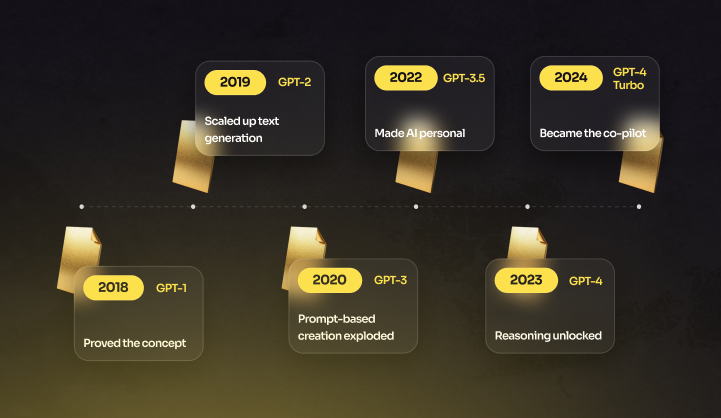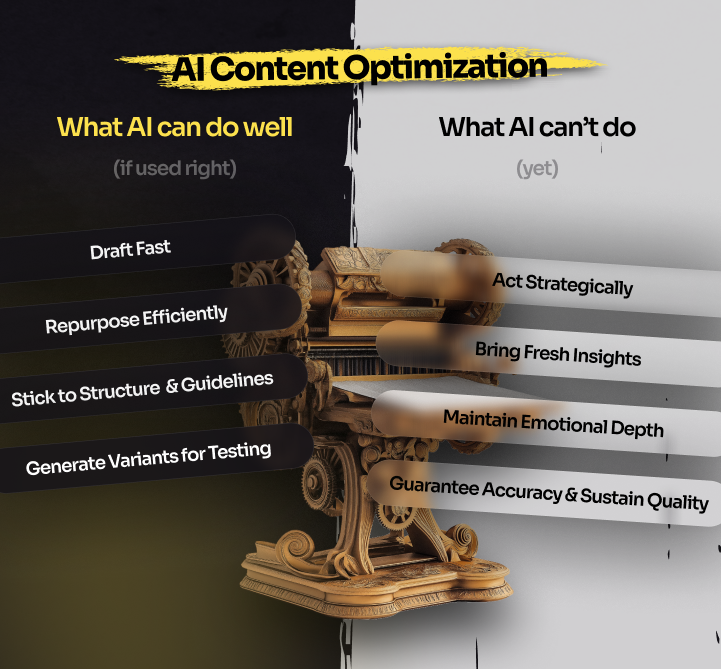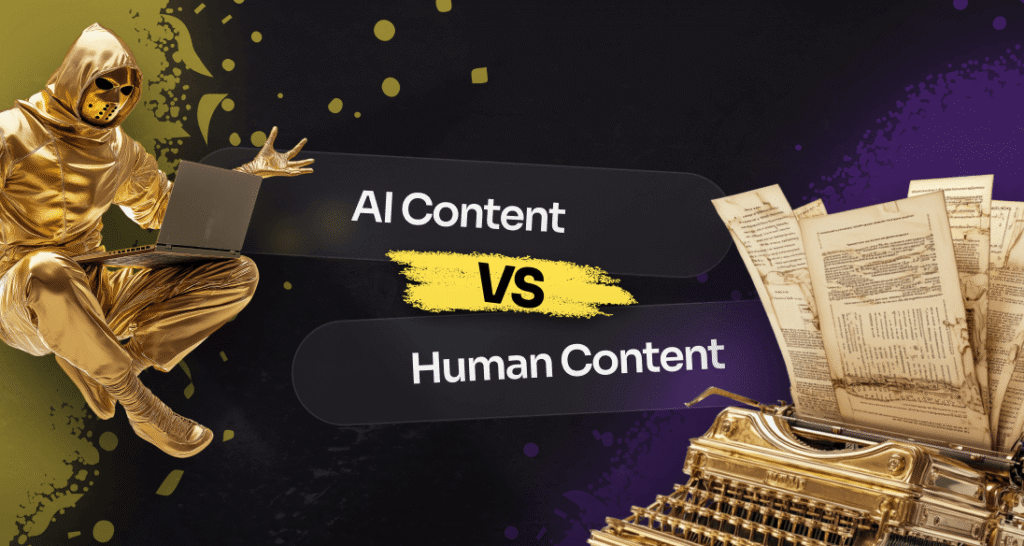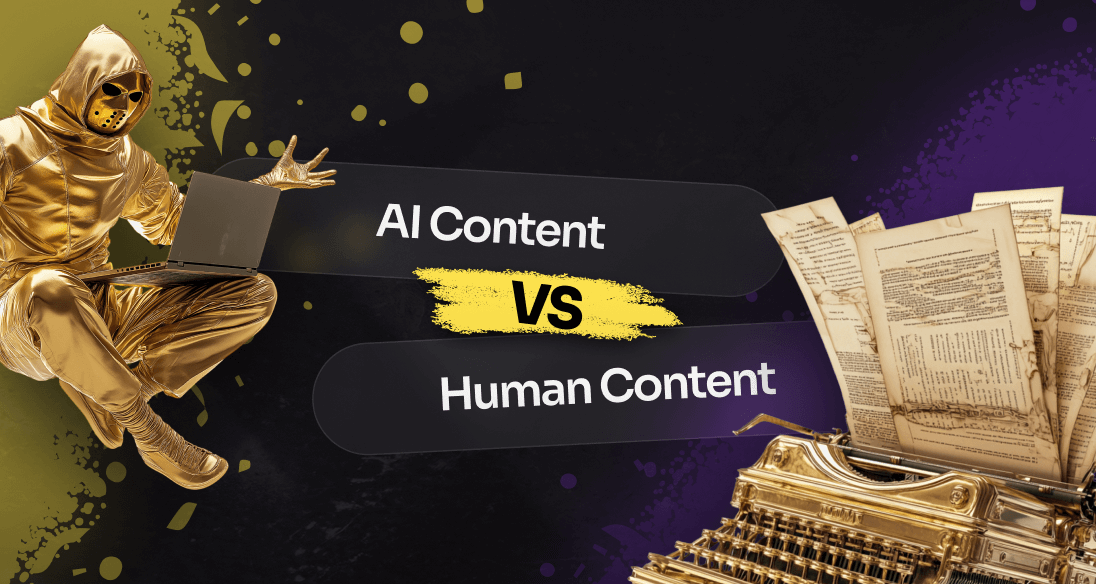AI content vs human content?
It has nothing to do with the battle. It’s all about strategy.
Tools like ChatGPT, Jasper, and Copy.ai have supercharged output. But flood the internet with copy-paste content and watch ROI sink.
With search algorithms cracking down on thin, recycled, and keyword-stuffed content, efficiency isn’t enough.
The smartest play? Collaboration. The edge goes to marketers who blend automation with substance.
The most effective content strategies don’t frame it as AI content vs human content - they use both. AI brings speed and scale. Human writers bring nuance, authenticity, and insight you can’t fake.
Let’s unpack where each excels and how to combine them into a strategy that gets the best of both.
The AI Content Tool Boom

AI content creation tools didn’t go mainstream overnight. It took years of research, billions of parameters, and one model that turned “what if” into “watch this.”
The tech that made it possible? Transformer architecture - introduced by Google and proposed in the 2017 paper “Attention Is All You Need.” Since the launch, it hasn’t leveled up AI tools - it has made them ready to take your job.
Two revolutions kicked off at once. OpenAI kept building smarter models, and startups built tools on top of them.
Let’s rewind to where the hype (and mild panic) began. To understand the hype, follow the upgrades.
- GPT-1 (2018) proved the concept: train a model on internet data, then fine-tune it for real tasks. It couldn’t reason or converse, but it laid the foundation for everything that followed.
- GPT-2 (2019) could write essays, summarize articles, and mimic human tone without task-specific training. The model still hallucinated and lacked logic. But it proved scale worked.
- GPT-3 (2020) changed the game. You gave it a prompt and it gave you results. Emails, blogs, poems, basic code, summaries, you name it. It wasn’t “smart;” it only sounded smart. Flawed logic. Fabricated facts. Still, light-years ahead of GPT-2.
- GPT-3.5 (2022) made it personal. ChatGPT gave everyone an on-demand “teammate” who never slept, never asked for a raise, and could crank out a first draft before your coffee cooled. The key shift? It could follow instructions, carry a conversation, and be helpful. It still made stuff up. However, it worked well enough that millions relied on it daily.
- GPT-4 (2023) brought reasoning into the mix. It could pass exams, write complex code, and even interpret images. Cleaner, sharper, more nuanced - closer than ever to a true thinking partner.
- GPT-4 Turbo (2024) became the co-pilot. Faster, cheaper, integrated with tools. It could generate images, interpret files, run code, and remember facts across chats. It became part assistant, part strategist.
While GPT was evolving in the lab, AI content tools were exploding in the market. Everyone raced to turn raw language models into useful, money-making machines.
Here’s how it played out:
- Jasper (formerly Jarvis) armed marketers with pre-built templates for blogs, ads, and landing pages - powered by GPT-3. It was like hiring ten copywriters with one click.
- Copy.ai zeroed in on startups and solopreneurs. Quick prompts in, polished emails, product descriptions, and social posts out.
- Writesonic married GPT-3 with SEO. Long-form blogs, meta tags, and SERP-ready headlines in minutes.
- Notion AI integrated strategic content support into your workspace, helping you draft notes, wikis, docs, and even generate ideas - without switching tools.
- Sudowrite gave fiction writers something new: an AI co-author that never runs out of ideas.
- Writer, Cohere, and Anthropic built their models optimized for accuracy, enterprise use, and ethical standards such as safety, transparency, and bias control.
- Google’s Bard (now Gemini) and Anthropic’s Claude emerged as OpenAI rivals - focusing on grounded responses and fewer hallucinations.
After years of upgrades and fine-tuning, different AI models finally made it easy for anyone to hit “generate.”
Everyone jumped on the AI train and it’s packed.
The strategy cart? Is it still empty?
What AI Can Do Well (If Used Right)
AI struggles with nuance, timing, and anything that requires judgment beyond the data it’s trained on.
But if used right, it helps you:
- Draft fast
AI handles high-volume content creation in seconds. Ideal for first drafts and killing the blank page. - Repurpose efficiently
One asset becomes many. AI can turn a blog into a LinkedIn thread, a webinar into an email series, or a customer case study into high-converting landing page copy. Fast and at low cost. - Stick to structure and rules
Give it a clear prompt or SOP, and AI sticks to your tone, voice, formatting, and templates with consistency. - Generate variants for testing
Need 12 ad angles or 5 subject line options? AI makes multivariate testing easy. - Handle basic SEO tasks
It can help with keyword placement, meta tags, headers, and readability improvements. It’s not a strategist, but it makes execution faster.

What AI Can’t Do Well (Yet)
Ignore the limitations, and AI will cost you more than it saves.
It’s still your job to:
- Act strategically
AI doesn’t understand your goals, pipeline, or positioning. It follows the brief. It doesn’t question it or pressure-test it. - Bring fresh insight or original thinking
AI has no POV. No expertise. It rephrases what’s already out there, and it won’t give you fresh takes or deep thinking that builds authority.
- Maintain emotional depth and true voice
The tone can be mimicked. Emotional intelligence can’t. Brands built on empathy, wit, or subtle storytelling still need a human voice behind the words.
- Guarantee accuracy
Stats, sources, even brand claims - none of it is verified. Every piece needs human fact-checking, especially in regulated or high-trust industries.
- Sustain quality in long-form
Short-form? It’s strong. But once you cross 1,500+ words, AI often repeats, drifts, or goes generic. Without editorial structure and cleanup, it won’t hit high standards.
AI tools don’t "know" your business or your audience’s intent. They guess, based on patterns. And pattern-based writing is exactly what Google is trying to filter out.
What AI Does Best (So You Don’t Have To)
Think of AI as having an assistant who never sleeps, helping you optimize and scale faster than your competition.
Here’s where AI crushes it:
- Keyword clustering: Analyzing massive data sets to surface ranking opportunities you would never spot manually.
- Outline optimization: Shaping content around the user journey and SERP needs based on search behavior.
- Technical SEO support: Handling meta tags, schema markup, and alt-text suggestions without needing three tools and a prayer.
- Content repurposing: Turning one long-form content into 10 short-form pieces in the blink of an eye.
AI Handles the What. You Own the Why.

Knowing what to write is easy. Knowing why, when, and for whom? That’s the hard part.
AI can surface the what:
- Trending topics
- Keyword gaps
- Competitor content
- SERP patterns
- Audience queries
But it takes strategy to figure out:
- Why it matters to your brand
- When it makes sense to publish
- Who needs to hear it
- Where it belongs across your channels
- How to say it in a way that drives action
Hitting publish means nothing if it doesn’t convert.
AI can help you fill the pipeline. But only strategy turns that into performance.
Signs Your Content Strategy Is Too AI-Heavy
If you’re not careful, AI can also help you blend in, get ignored, and slowly sink your performance.
If any of these rings a bell, you’re already there:
1. Same content, different logo
Same topics. Same structure. The same safe takes. It repeats what’s already ranking and never says anything new.
2. No POV, no personality
You can feel the prompt, not the author. Looks like content. Reads like air.
3. Rankings are stuck. Traffic’s sliding.
If rankings are stuck, your AI-generated content might be too. Over-optimized, low-value content gets flagged quickly.
4. Engagement metrics tanking
High bounce rates + low time-on-page = content that doesn’t resonate.
And if you're rethinking your content strategy, here’s where to start: Content Marketing Services.
Creating the Ideal Hybrid Strategy
AI doesn’t replace content strategy. It replaces wasted time. Start by drawing a clear line between what can be automated and what still needs a human brain.
Step 1: Divide & Conquer
Use AI for:
- Research and SERP analysis
AI tools like ChatGPT, Jasper, and Perplexity can scan competitors, identify ranking patterns, and suggest keyword clusters in seconds. A task that stole hours? Done in minutes. - Drafting structure and headlines
AI simplifies the setup: outlines, headlines, content structure, style options, and everything in between. Use it to spark your first sentence, not to carry the whole piece.
- Scaling FAQs, product descriptions, or listicles
Repetitive, format-driven content? That’s AI’s sweet spot. Perfect for bottom-funnel pieces that follow clear rules and require zero storytelling.
Use humans for:
- Thought leadership and storytelling
This is where brands win attention and build trust. AI can’t inject personal anecdotes, lived experience, or original POVs. Human-generated content brings the one thing AI can’t: judgment. - Final editing and brand voice alignment
Rhythm, timing, dry humor, subtle tension: that’s human territory. You don’t outsource your brand voice to autocomplete. - Deep-dive content like whitepapers or strategy guides
When the stakes are high, AI is risky. You don’t want AI guessing on your behalf in a 15-page report.
Step 2: Build a Workflow That Merges Both
Let each side support the other: AI with structure and humans with meaning.
Here’s the example of how to create a scalable, hybrid content process that plays to AI’s strengths - without losing what makes your brand human.
Step 1: Let AI build a strategic outline based on a target keyword cluster and SERP research.
(Tools: ChatGPT, Surfer, Jasper)
Step 2: Add your POV, strategic direction, and narrative flow
Real insights, not recycled content. AI follows patterns. Human creativity breaks them.
Step 3: Use AI tools to handle SEO tweaks like meta tags, headers, or internal links.
(Tools: Clearscope, MarketMuse, SurferSEO)
Step 4: Polish tone, tighten flow, and add the CTA
This is where clarity drives action, emotion drives trust, and brand voice drives conversion. Human expertise is what keeps content relevant, accurate, and strategic
Step 5: Use AI-powered SEO tools to validate and score
Once the final draft is polished, run it through your SEO tools to check for gaps and performance potential. AI is useful for creating content fast - but the speed only matters if you’re directing it toward something specific: a question, a need, a conversion point.
Step 6: Publish, track, and reuse
Monitor performance using tools like Google Search Console. Look at what ranks, what gets ignored, and where drop-off happens. Repurpose high quality content using AI tools.
| Task | AI Role | Human Role |
| Keyword Research | Generate keyword clusters based on SERP and intent. | Select and prioritize based on strategy and goals. |
| Outline Creation | Draft a structured outline tied to target keywords. | Inject POV, add narrative flow, and define strategic direction. |
| First Draft Generation | Produce initial content based on outline and prompts. | Layer in original insights, storytelling, and human tone. |
| SEO Optimization | Handle meta tags, headers, internal links, and readability. | Review for accuracy, ensure SEO tweaks support real user intent. |
| Tone, Brand, and CTA Alignment | Suggest variations if prompted (basic tone shifts). | Final polish: sharpen tone, ensure brand consistency, and craft CTAs that drive action. |
| Content Validation and Scoring | Score draft for SEO gaps and SERP match. | Review scores and adjust the content based on performance goals, not just SEO "compliance." |
| Publishing and Repurposing | Automate format adjustments for reuse (e.g., blog to LinkedIn post). | Approve final messaging, adapt content to platform-specific needs, and track results. |
This structure reduces first-draft time by 50-70% without sacrificing quality. It clears the clutter so your team can double down on strategy and build what converts.
If speed were all that mattered, AI content optimization tools would be your CMO by now.
The goal isn’t to replace human written content - it’s to combine the scale of AI with the depth, clarity, and control that only a human can bring.
If AI is driving the structure, the pace, and the positioning, then all you’re doing is dressing automation in human clothes.
The content creation process isn’t just about output - it’s about ownership.
When to Avoid AI in Content Creation
The biggest risk with AI isn’t misuse - it’s overconfidence. The more you trust it blindly, the more likely you are to publish something inaccurate, tone-deaf, or legally risky.
Here’s when you should keep AI out of the process:
- Anything where accuracy is non-negotiable
One wrong phrase (hallucinated or outdated) and you're not just misinforming people, you’re risking liability. AI doesn’t come with accountability.
- Content that sits in public trust zones
Product disclaimers, accessibility guidelines, safety protocols - this isn’t where you experiment with machine-generated nuance. These pieces need human review, not guesswork.
- Content tied to legal or ethical consequences
If you're not ready to defend it in a room, don’t delegate it to an algorithm.
- Real-time or context-sensitive messaging
AI tools can’t read the room. Whether it’s a response to cultural events, internal crises, or time-sensitive statements - precision matters. Context matters. And AI lacks both. Only humans can craft content that shifts thinking, builds trust, or drives action.
Content that demands empathy, nuance, or rapid tone shifts across writing styles isn’t where AI shines. If your piece needs to move from education to urgency, it needs a human.
Let AI accelerate the workflow. But where trust, context, or compliance is in play - humans lead. For now.
Wrap Up
AI scales, systemizes, and doesn’t sleep. Ultimately, humans craft the narrative, calibrate the tone, and deliver with precision.
It’s not about who writes, it’s about what performs.
AI can’t replace content teams. Writers don’t get replaced. They get upgraded. AI can turn them into strategists who publish smarter, test faster, and scale what actually converts.
But if you’re using AI to push out large volumes of content without human input, you're not accelerating - you’re drifting.
Forget chasing volume. Make decisions that drive traffic, earn attention, and generate leads.
Here’s the essential formula:
- Let AI do the grunt work
- Let humans inject soul, insight, and strategy
- Use data to optimize every step
The brands winning in 2025 aren’t guessing. They’ve built a system that works - and cut everything that doesn’t. So, don’t let your next blog post be another piece of AI filler.
Frequently Asked Questions
Q: What works better for SEO: AI-generated content or human-written content?
A: Neither AI-generated content nor human-written content automatically performs better for SEO. What matters is how you use them. AI speeds up production and handles volume, but human writers deliver the originality, depth, and emotional resonance that search engines and audiences reward. The strongest SEO strategies today combine AI’s efficiency with human storytelling and strategic depth.
Q: What are the advantages of using AI for content creation?
A: AI helps marketers draft content faster, repurpose existing assets into new formats, maintain brand consistency through templates, generate multiple testing variations, and complete basic SEO tasks without manual effort.
Q: What are the major limitations of AI-generated content?
A: AI content lacks strategic thinking, emotional nuance, and original points of view. It cannot independently guarantee factual accuracy, maintain narrative depth over long-form content, or tailor messaging to complex audience needs without human guidance and review.
Q: How does AI add value to a content marketing strategy?
A: AI adds value by automating repetitive tasks such as keyword research, content outlines, technical SEO improvements, and content repurposing. It allows human creators to spend more time on storytelling, brand positioning, and creating high-value content that resonates.
Q: How can you tell if your content strategy relies too much on AI?
A: If your content feels generic, lacks a clear point of view, sees declining rankings, or experiences poor engagement metrics like high bounce rates, it may be a sign that your strategy is overly dependent on AI-generated content without enough human refinement.
Q: When should you avoid using AI for content creation?
A: You should avoid using AI for any content where legal accuracy, public trust, or real-time sensitivity is critical. Tasks like regulatory statements, crisis communications, product safety disclaimers, and high-stakes storytelling still require careful human control.
Q: How do you build an effective hybrid workflow for content creation?
A: To build a high-performing hybrid workflow, start by letting AI tools handle initial research, outlines, and repetitive content formats. Then, have human writers add strategic insights, shape brand voice, and refine the content for accuracy and depth. Final steps should include human editing, SEO validation, and performance tracking to ensure each piece delivers measurable impact.






